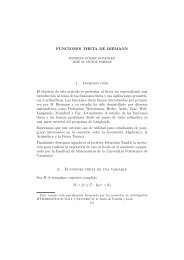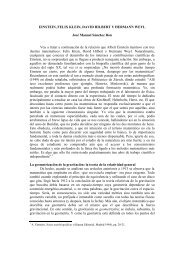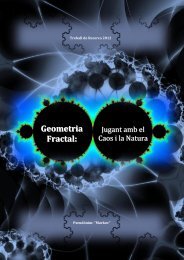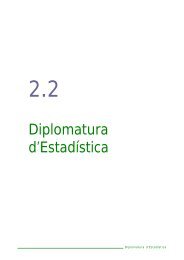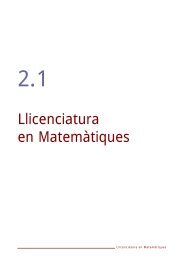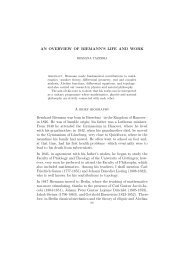Bernhard Riemann (1826 Bernhard Riemann (1826-1866) Bernhard ...
Bernhard Riemann (1826 Bernhard Riemann (1826-1866) Bernhard ...
Bernhard Riemann (1826 Bernhard Riemann (1826-1866) Bernhard ...
Create successful ePaper yourself
Turn your PDF publications into a flip-book with our unique Google optimized e-Paper software.
► <strong>Riemann</strong> considered an appropriate new basis and<br />
compared the two forms associated to the “particle of<br />
substance” b ” at times t and d t’. ’ The h difference dff between b the h<br />
two forms is given by<br />
2 2 2 2 2 2 2<br />
δ ( ds) = ds'<br />
−ds<br />
= ( G −1)<br />
ds + ( G −1)<br />
ds + ( G −1)<br />
ds<br />
where<br />
ds<br />
1<br />
, ds<br />
2<br />
, ds<br />
3<br />
is<br />
1<br />
the<br />
new<br />
1<br />
basis.<br />
His result can be interpreted in terms of the classical<br />
theory y of elasticity. y Since ether is an elastic, , homogeneous g<br />
and isotropic substance, then one can consider an<br />
infinitesimal displacement u and deduce that the difference<br />
δ(ds) depends on the strain tensor due to the<br />
displacement. <strong>Riemann</strong> supposed that this variation δ(ds)<br />
produced a force able to modify the particle in such a way<br />
that the same particle, by opposing this deformation, would<br />
propagate p p g the pphysical y forces through g space. p<br />
2<br />
2<br />
3<br />
2<br />
3



